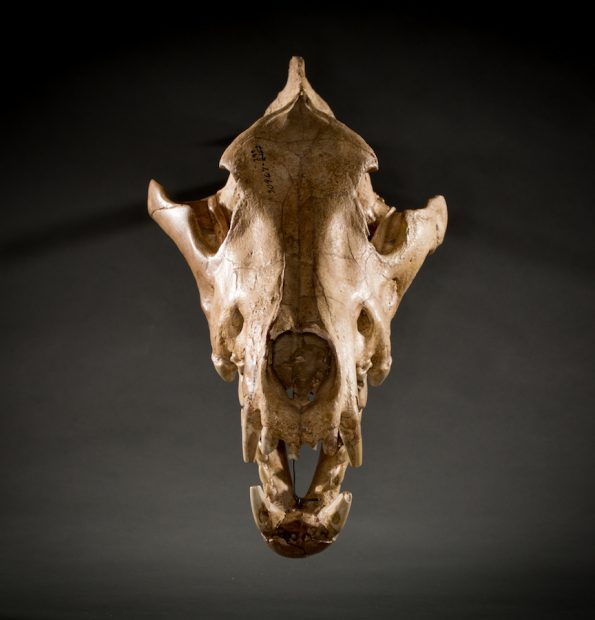
Photograph by Sarah Wilson
Photographer Sarah Wilson stands in a specimen-cluttered room of UT’s Vertebrate Paleontology Laboratory, carefully cradling a pint-sized skull in her palms while considering its paleontological and personal significance. The early primate skull, “Rooneyia viejaensis,” was discovered by her grandfather in 1964 and is a holotype — a specimen upon which the description and name of a new species is based — and its visible endocast of the brain and well-preserved inner ear proves informative for paleontologists.
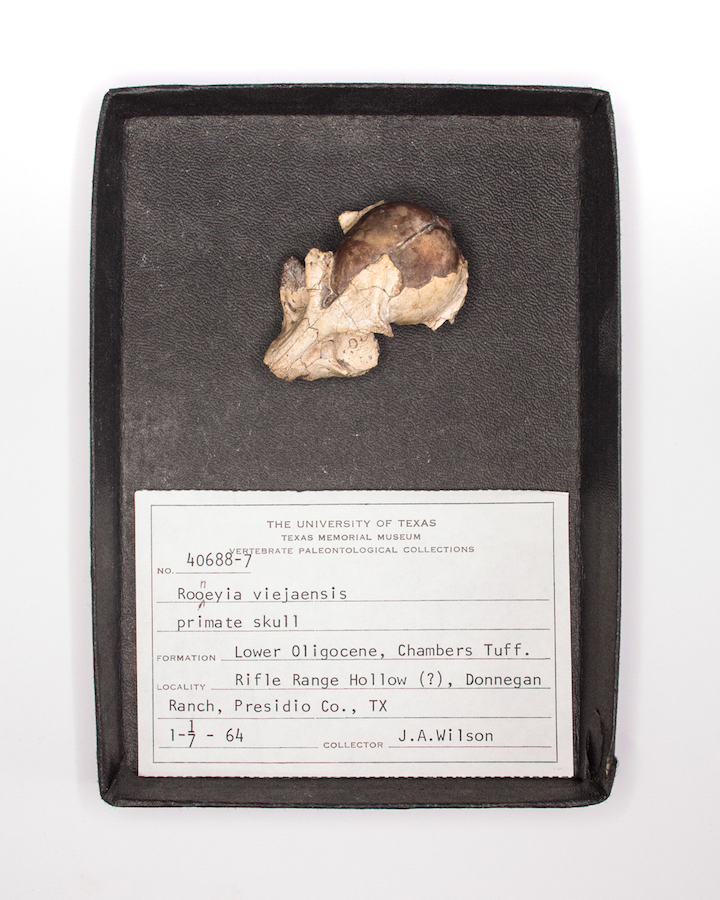
Photograph by Sarah Wilson
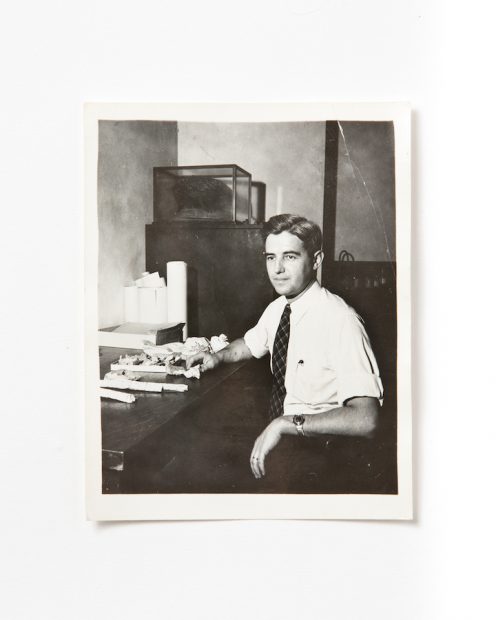
Dr. John A. (Jack) Wilson
Granddaughter of Dr. John A. (Jack) Wilson, a paleontology professor who established the Vertebrate Paleontology Lab at The University of Texas at Austin’s J.J. Pickle Research Campus in 1949, Sarah Wilson creates visual art from the lab’s collection of over one million bones, sourced from the American Southwest and all over the world. Wilson is the official artist-in-residence at the lab, where she occasionally visited her grandfather at work in the ‘80s. Wilson’s images modernize the ancient specimens, transforming them from archival materials sitting in dusty drawers to well-lit studio subjects, enhanced with personality and meaning. Wilson turned her gaze to the lab after accompanying paleontologist Chris Kirk, who continues the work her grandfather started, on a dig in Big Bend — one of Texas’ richest paleontological sites.
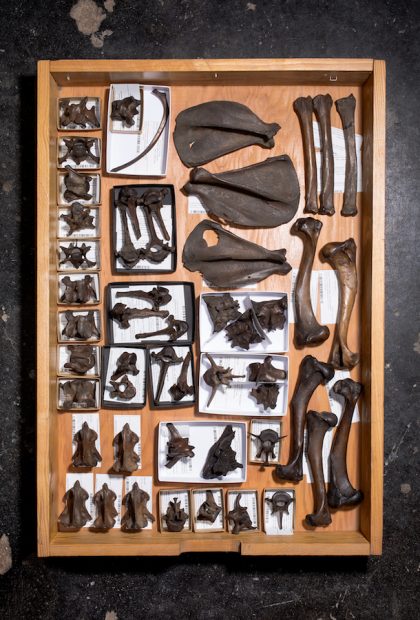
Photograph by Sarah Wilson
“Being on digs and doing the more documentary version of shooting, we’d be out there, and I’d be photographing these beautiful landscapes, but we wouldn’t be finding those femur bones or huge skulls out there, like my grandfather did.” Wilson knocks on wood. “Next time,” she laughs. “So I wanted to highlight some of the jewels of the collection.”
For Wilson, a love of West Texas and the Big Bend region began in 1999. One summer on a holiday break from NYU’s Tisch School for Photography, she landed an internship at Texas Monthly. While flipping through back issues in her cubicle, she stumbled across a photo essay by photographer James Evans, who is famous for documenting West Texas and is the owner of Evans Gallery in Marathon. Wilson decided to take a road trip to Big Bend that next weekend, and to contact Evans. A casual visit and a cup of coffee turned into an internship out West the following summer.
“It started me down the path of portraiture and documentary photography. It was the first time I had the courage to approach people and ask to take their portrait. I had a project, I had a mission,” Wilson says. “This small community of Marathon was full of interesting people, and at least for that summer, I felt like I was a part of it.”

Photograph by Sarah Wilson
Flash forward to eight years later, when Wilson found herself again in West Texas, shooting a cover story about Big Bend for Texas Monthly in 2007. Wilson says she was initially intimidated by the assignment, presenting her own personal interpretations and making interesting images from a heavily-covered area. She spent three weeks alone shooting, looking for shots that pushed emotional boundaries.

Photography by Sarah Wilson
“It was an awesome experience, and it really set off my personal interest in the area and my own voice about West Texas,” says Wilson. “The restrictions and structures of life become less out there, and there’s more space to breathe, more space to think.”
Wilson describes paintings of West Texas that graced the walls of her grandparent’s Lake Travis home, with bowls of rocks giving the home an adventurer’s spirit. She remembers sharing the photographs she took of Big Bend for the Texas Monthly assignment with her grandfather, which started a deep connection between the two of them over a shared loved for wild desert landscapes.
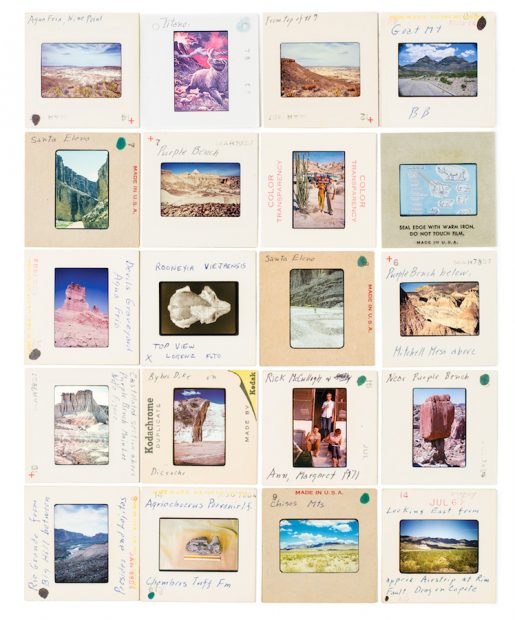
Photograph by Sarah Wilson
“He was more of a professorial-minded person, as opposed to, like, a warm and fuzzy grandpa, so having this new point of connection was exciting for me,” says Wilson. “It was a year or so later that my grandfather gave me his teaching slides, three boxes of photographic transparencies of bone fragments, landscapes and charts, that he used to illustrate his lectures at UT.”

Photograph by Sarah Wilson
Her grandfather was 94 years old when he came down with a fatal case of pneumonia in 2009. While he was in the hospital for treatment, Wilson brought a picture of an ocotillo plant she shot near the road to Castolon Peak, Big Bend, to liven up his otherwise colorless hospital room.
“It was interesting, because his mind was so fully intact. He could recognize all the rock formations, and he knew exactly where I had shot that picture,” says Wilson. “It was this beautiful moment that we shared. He ended up dying three hours later.”
Wilson says she had a realization at his funeral that her grandfather’s work spans eternity, and although he was no longer living, his work and what he started at the lab and on his digs would live on.
“He had his hands on prehistoric mammal and dinosaur bones. So it was kind of — I don’t know — I wasn’t so sad about his leaving,” says Wilson. “After that, I started to look deeper at these slides and realized that we had been photographing at some of the same points within Big Bend National Park and had a shared vision of the place itself.”
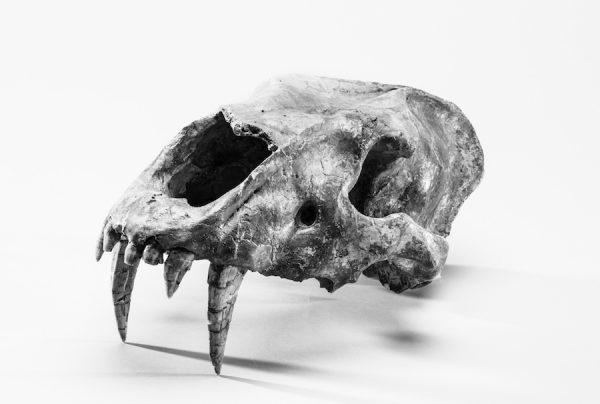
Photograph by Sarah Wilson
Shortly after her grandfather’s passing, Wilson visited the lab for the first time since her childhood, to see if any staff members there would find his teaching slides useful. She met Matthew Brown, the lab’s director, who would act as a creative partner during her photo shoots at the lab, as well as Chris Kirk, who she’d later accompany on digs to West Texas.
Wilson says that the digs, grounding and meditative in nature, help her stay in touch with her grandfather and offer continuous learning experiences. “I really feel fortunate that I can camp and hike with a group of paleontologists and be able to see the park in a more in-depth way. We’re off the beaten path but have a destination and purpose of being there,” says Wilson. “I have a reason to not only join in on this scientific mission, to find more bones for the collection and for research, but also to participate in a familial tie. As a group, we’re following in the footsteps of my grandfather, and we’re trying to find more of what he found.”
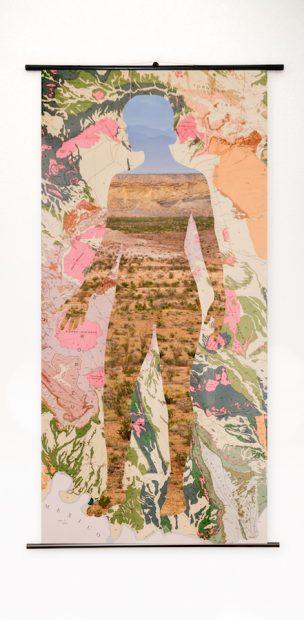
Artwork by Sarah Wilson
Some of Wilson’s artworks that are driven by this narrative are her anatomy posters, which appear as pull-down scientific charts hanging on the wall in her studio. One chart depicts desert terrain in the shape of her silhouette against stratigraphic maps. “I’m trying to translate what it feels like when I am out in the field, when I’m face down in the rock, looking for scraps of bone,” Wilson says. “I feel at one with the earth, and that it’s not about me and my ego. It’s about really being enmeshed with the landscape, with history and with evolution.”
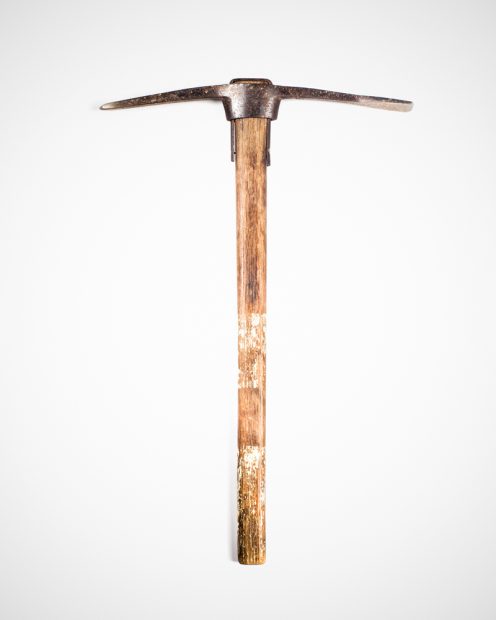
Photograph by Sarah Wilson
On a vision board in Wilson’s studio, every aspect of the project is tacked up for digestion: old photos of the lab; stills of timelapse videos she’s made from the lab’s ‘bug room;’ dramatic portraits of a dire wolf skull, jaw agape; a selfie of Wilson next to a ginormous Quetzalcoatlus wing; landscape shots; slides; portraits she’s taken of lab employees — the list goes on.
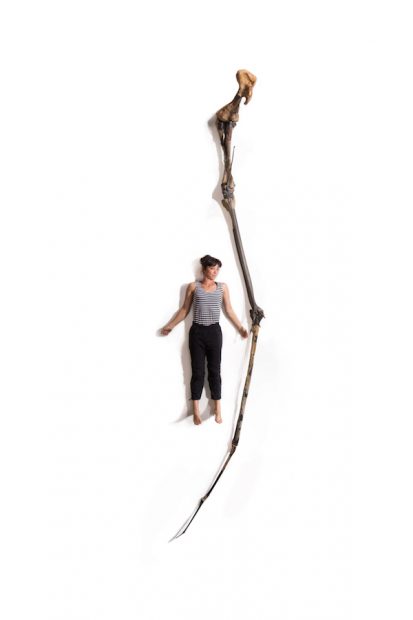
The Quetzalcoatlus wing selfie is one of the most arresting images on the board. Wilson, 5’6, lies next to a 15-foot dinosaur wing against a stark white background. It was shot from the lab’s first floor loading dock down into the basement of the lab, which used to be an old magnesium factory. Portraits of Wilson’s grandfather sporting his famous bolo tie collection give a face and a warmth to Wilson’s collection of images. She’s also created blown-up, multi-media sculptures that look like her grandfather’s teaching slides, only about 250 times larger. The transparencies are backlit as if they were being shown on a projector.
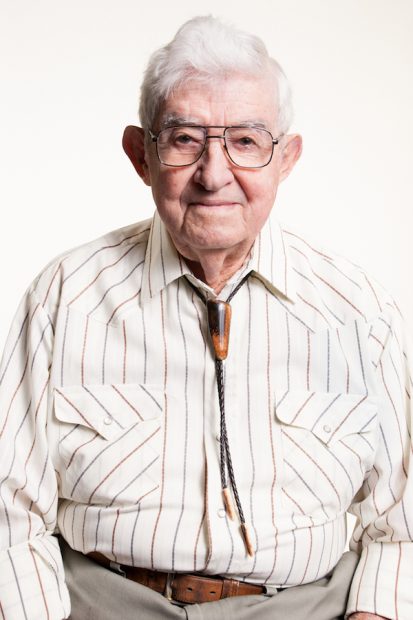
Photograph by Sarah Wilson
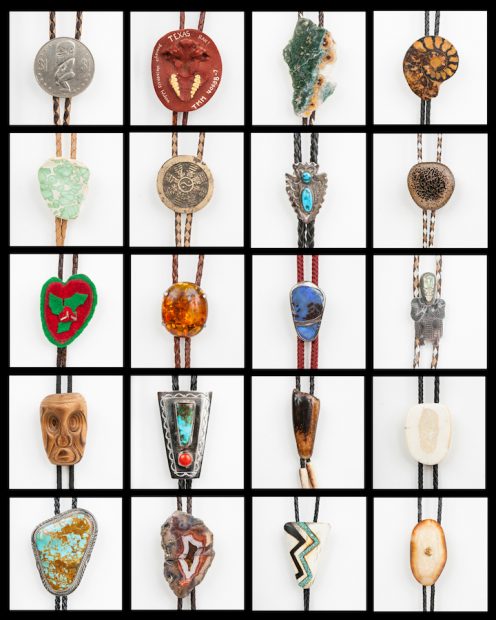
Photograph by Sarah Wilson
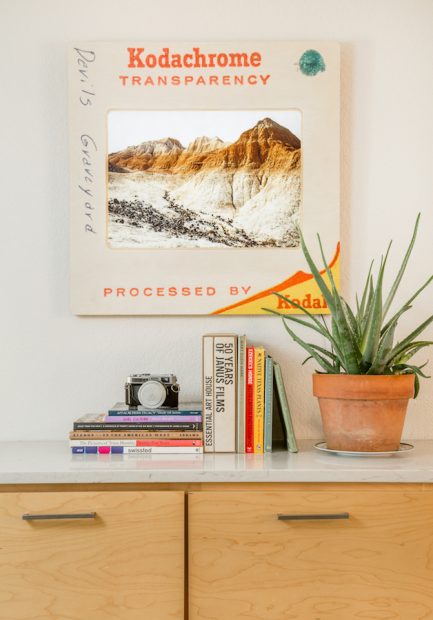
“I wanted to preserve the look of the original slide mount, with my grandfather’s handwriting on it. I love the design and the old Kodachrome logos,” Wilson says. “I feel like these vintage slides are artifacts in and of themselves.”
When asked about the ideal viewing location for her work, Wilson says she envisions a cross between an art gallery and a natural history museum. While the artwork Wilson creates from the lab is rooted in a personal story, she also wants a potential show to reach people on a practical and political scale.
“Right now, I’m amassing it and figuring out what this message is and how to best combine all these images to help put my life into perspective and into context, set against the millions and millions of years of evolution and progression that has come before us,” says Wilson. “That’s the part I’m trying to clarify… . It’s not just about my personal experience, but it’s about where I feel we are as a whole, as a species.”
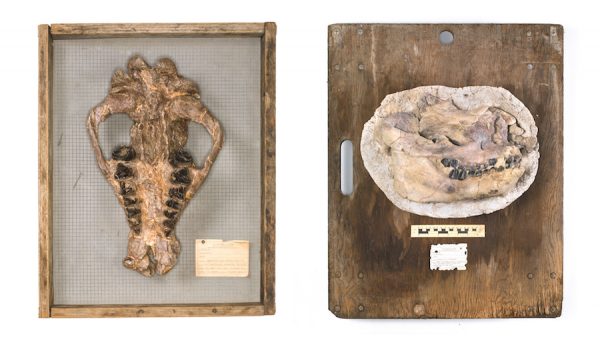
Photograph by Sarah Wilson
Wilson lists climate change and current political leadership as motivators for creating and sharing her work. By giving these ancient bones a wider audience, she hopes to remind people of the concept of looking into the past to learn something about the future.
“It feels like there’s not a lot of hope right now, in the fight against the steamrolling nature of capitalism, and power and big money — I sometimes feel that greed is overtaking, and I would like to see a change in that,” Wilson says. “And have some people in power that consider the planet and all the other life forms to be as important as ourselves.”
The intergenerational aspect of Wilson’s work goes beyond the connection with her grandfather, and includes her three-and-a-half-year-old son, Theo, who she hopes to take on a dig one day. A photo of him she recently took at the lab shows him lying between two massive mastodon femur bones, and was created with the help of current lab director Matt Brown, who has helped Wilson during all of her shoots at the lab.
“At the lab, I feel as though I’ve joined another family that I never would have known had I not brought those slides in that day,” says Wilson. “If they were stodgy people who didn’t appreciate strange artists coming in and hanging out for hours and hours, it wouldn’t be the same.”

Dr. Ernest Lundelius. Photograph by Sarah Wilson
Dr. Ernest Lundelius, “Ernie,” one of her grandfather’s contemporaries, and one of his first grad students, still goes into work every day at the lab. The same was true for her grandfather and another previous director, Wann Langston, who both worked in the lab well into their 90s. “I like to be around people that are so jazzed about what they do for a living that they don’t feel the need to retire from it,” says Wilson.
In her grandfather’s absence, Wilson says Ernie has helped answer questions she didn’t know to ask when her grandfather was still alive. Having a representative from that time period helps put the work in context, a reminder of what West Texas was like back in 1964.
“Ernie’s kind of like the embodiment of my grandfather for me right now,” says Wilson. “His office looks like my grandfather’s used to look. He’s surrounded by all old books and stained 40-year-old mugs. He drinks strong coffee all day — like, jet fuel. There’s just all these little details about who he is that are his own, but they remind me of the type of person that my grandfather was.”
Many of the early directors of the lab grew up during the Great Depression and were ex-military, so nothing went to waste. A nostalgia for the past is evident at the lab, where bones are sometimes still housed in the vintage packages they were collected in 60-plus years ago, including a pack of Australia’s Redhead’s safety matches from the ‘40s and ‘50s, or boxes for Falstaff Beer, which was popular in the ‘60s and is no longer produced. The lab will occasionally post these on its Instagram account, @texasvertpaleo.

Sarah Wilson and her grandfather.
“Almost nothing is glossy or modern here. The furniture, office supplies, specimens, and the people — even the young students and staff have a timeless nature,” says Wilson. “I think this enhances the feeling of the place, as a monument to age and time.”



10 comments
What a great article!
I really love this piece.
Love this combination of geology and art. You are telling a story of history
Great story – a valuable combination of history, family, nostalgia, science, photography, art, and some hope. Thanks
I have yet to see any of Sarah’s projects that she hasn’t been both physically and emotionally immersed in.
Sarah has a talent for seeing beyond the naked eye with a depth that few can capture. She puts her heart and soul in all she does.
I especially love this project because it furthered her connection with her grandfather and his lifetime of work.
I am so proud of Sarah for sharing this project publicly and for the work she’s doing, alongside those who are continuing her grandfathers work.
As always Sarah, your work is awesome and meaningful!
Bravo!
Thank you Sarah and Mary, I was pleasantly transported in time and space! Loved the bolo collection image you shared as well.
Let me add my thanks for a lovely article, which also gave me fresh perspectives of photography as an art form!
You’re doing a fabulous job Christina.
Loved this article
I’m grateful for the opportunity to share this project on Glasstire. Thanks so much to Mary Cantrell for your beautiful writing, and for making the trek out to the paleontology lab with me. I loved introducing you to the crew out there.
What a beautifully written piece to honor Sarah’s grandfather—- mixing science and art!! The writing was stellar, meaningful and moving!